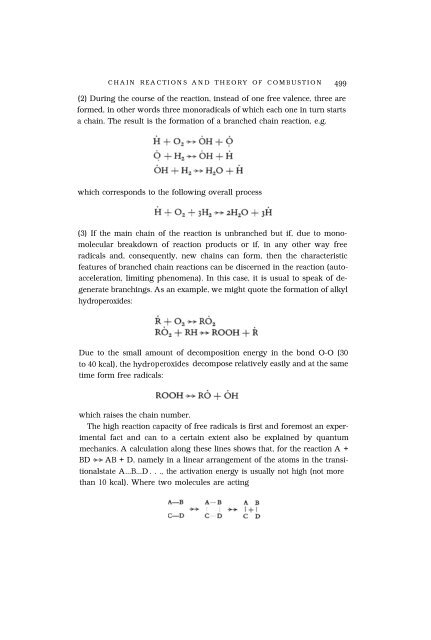Nikolai N. Semenov - Nobel Lecture - Nobelprize.org
Nikolai N. Semenov - Nobel Lecture - Nobelprize.org
Nikolai N. Semenov - Nobel Lecture - Nobelprize.org
Create successful ePaper yourself
Turn your PDF publications into a flip-book with our unique Google optimized e-Paper software.
CHAIN REACTIONS AND THEORY OF COMBUSTION 499<br />
(2) During the course of the reaction, instead of one free valence, three are<br />
formed, in other words three monoradicals of which each one in turn starts<br />
a chain. The result is the formation of a branched chain reaction, e.g.<br />
which corresponds to the following overall process<br />
(3) If the main chain of the reaction is unbranched but if, due to monomolecular<br />
breakdown of reaction products or if, in any other way free<br />
radicals and, consequently, new chains can form, then the characteristic<br />
features of branched chain reactions can be discerned in the reaction (autoacceleration,<br />
limiting phenomena). In this case, it is usual to speak of degenerate<br />
branchings. As an example, we might quote the formation of alkyl<br />
hydroperoxides:<br />
Due to the small amount of decomposition energy in the bond O-O (30<br />
to 40 kcal), the hydroperoxides decompose relatively easily and at the same<br />
time form free radicals:<br />
which raises the chain number.<br />
The high reaction capacity of free radicals is first and foremost an experimental<br />
fact and can to a certain extent also be explained by quantum<br />
mechanics. A calculation along these lines shows that, for the reaction A +<br />
BD ++ AB + D, namely in a linear arrangement of the atoms in the transitionalstate<br />
A...B...D . . ., the activation energy is usually not high (not more<br />
than 10 kcal). Where two molecules are acting
















